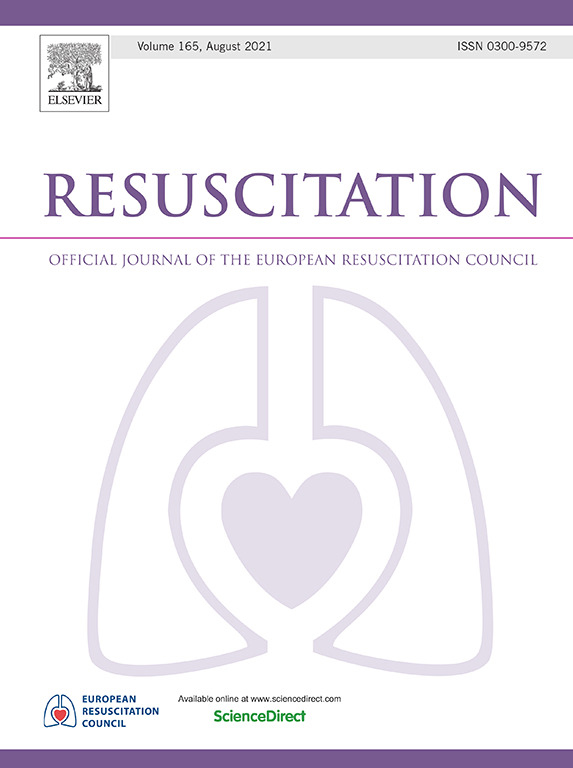先天性膈疝新生儿产房插管时血流中断。
IF 4.6
1区 医学
Q1 CRITICAL CARE MEDICINE
引用次数: 0
摘要
目的:血流中断(FDs)是指在护理过程中出现的偏差,损害了特定过程的安全性和效率。新生儿插管是中重度先天性膈疝(CDH)新生儿产房(DR)管理中需要的一种挽救生命的高风险手术。本研究评估了新生儿CDH DR插管期间的FDs及其与过程和结果测量的关系。方法:单中心观察录像DR插管治疗新生儿CDH。从出生到有创气管插管通气开始测量FD,并使用新生儿FD工具和影响评分进行分类。主要观察指标为有创通气时间。次要终点为至血氧饱和度(SpO2)≥85%的时间、至心电图信号的时间、至脉搏血氧仪信号的时间、至气管插管固定的时间。线性回归模型评估通气前FD率/分钟与预后的关系。结果:在2021年11月至2023年4月期间,共纳入29例录像复苏。通气前平均为7.1 FDs/分钟(±3.2)。高冲击fd的发生率与通气延迟有关;高冲击FD率每增加1 FD/分钟,通气延迟19.0秒(95%可信区间4.6-33.4),脉搏血氧仪采集延迟。中度冲击fd的发生率与SpO2延迟≥85%相关。结论:新生儿CDH在DR插管过程中常发生FDs,且高冲击性FDs与启动有创通气的时间较长有关。fd是改善CDH插管的可修改目标,并可推广到其他新生儿插管。缩写:CDH:先天性膈疝,DR:产房,ETT:气管内插管,FDs:血流中断,IQR:四分位范围,LHR:肺与头比,NRP:新生儿复苏计划,O/E LHR:观察到的与预期的肺与头比,PICU:儿科重症监护病房,SD:标准差,SDU:特殊分娩病房,SpO2:氧饱和度。本文章由计算机程序翻译,如有差异,请以英文原文为准。
Flow disruptions during delivery room intubation of neonates with congenital diaphragmatic hernia
Aim
Flow disruptions (FDs) are deviations in the progression of care that compromise safety and efficiency of a specific process. Neonatal intubation is a life-saving high-risk procedure required for delivery room (DR) management of neonates with moderate to severe congenital diaphragmatic hernia (CDH). This study evaluated FDs during DR intubation of neonates with CDH and their association with process and outcome measures.
Methods
Single-center observational study of video-recorded DR intubations of neonates with CDH. FDs were measured from birth through commencement of invasive endotracheal tube ventilation and classified using a neonatal FD tool and impact score. The primary outcome was time to invasive ventilation. Secondary outcomes were time to oxygen saturation (SpO2) ≥85 %, time to electrocardiogram signal, time to pulse oximetry signal, and time to secured endotracheal tube. Linear regression models evaluated the association of FD rate/minute before ventilation and outcomes.
Results
Between 11/2021 and 4/2023, 29 video-recorded resuscitations were included. A mean of 7.1 FDs/minute (±3.2) occurred before ventilation. Rate of high impact FDs was associated with a ventilation delay; a one FD/minute increase in rate of high impact FDs was associated with a 19.0 s (95 % confidence interval 4.6–33.4) ventilation delay and delay in pulse oximetry acquisition. Rate of medium impact FDs was associated with a delay in SpO2 ≥85 %.
Conclusion
FDs occur frequently during DR intubation of neonates with CDH, and high impact FDs are associated with longer time to initiate invasive ventilation. FDs represent modifiable targets to improve CDH intubation and may generalize to other neonatal intubations.
求助全文
通过发布文献求助,成功后即可免费获取论文全文。
去求助
来源期刊

Resuscitation
医学-急救医学
CiteScore
12.00
自引率
18.50%
发文量
556
审稿时长
21 days
期刊介绍:
Resuscitation is a monthly international and interdisciplinary medical journal. The papers published deal with the aetiology, pathophysiology and prevention of cardiac arrest, resuscitation training, clinical resuscitation, and experimental resuscitation research, although papers relating to animal studies will be published only if they are of exceptional interest and related directly to clinical cardiopulmonary resuscitation. Papers relating to trauma are published occasionally but the majority of these concern traumatic cardiac arrest.
 求助内容:
求助内容: 应助结果提醒方式:
应助结果提醒方式:


